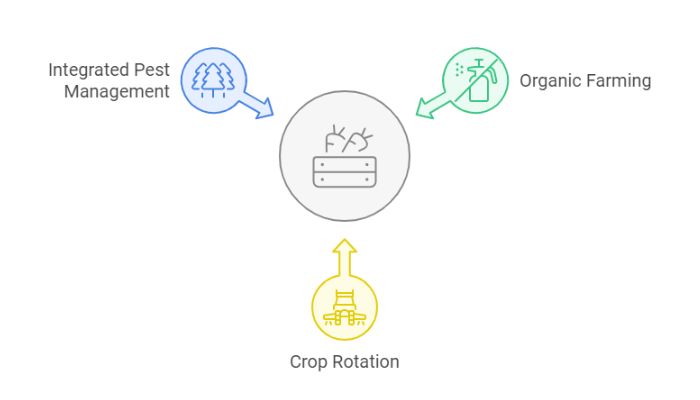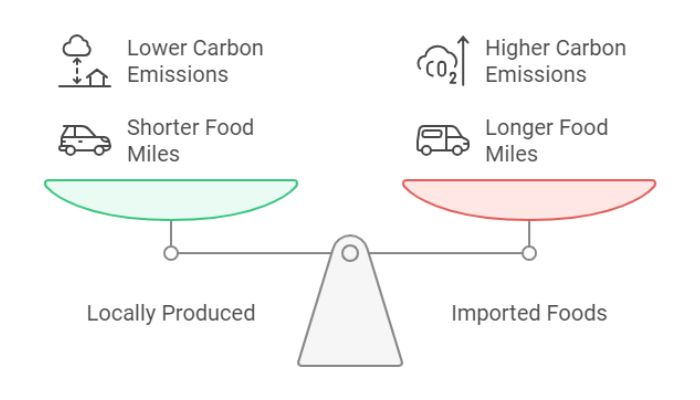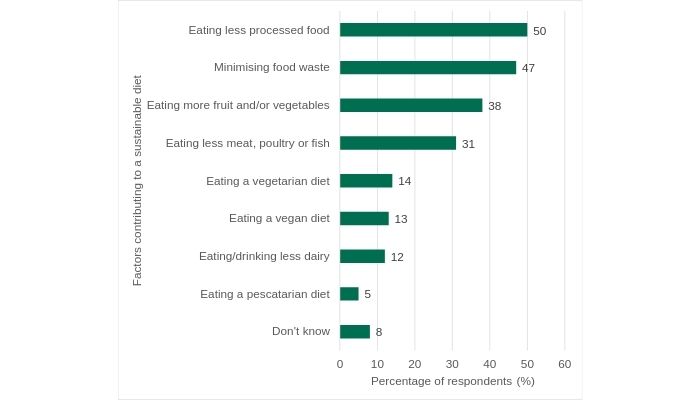Sustainable food is food that is grown, processed, and eaten in ways that are good for the planet and people. It means producing food without harming the environment, supporting local farmers, and ensuring fair treatment of workers.
Key aspects include:
- Responsible Farming
- Ethical Sourcing
- Minimizing Waste
Organic, locally sourced, and fair-trade foods are all part of sustainable eating, but they are not exactly the same.
| Organic Food | It is grown without synthetic chemicals or fertilizers, which is better for the soil and water. |
| Locally Sourced Food | It is grown close to where it is sold, reducing the need for long-distance transport, which lowers pollution. |
| Fair-Trade Food | This ensures that farmers are paid fairly for their products and work under safe conditions. |
1. Why Is Sustainable Food Important?
Sustainable food is important because it helps protect the planet, supports local communities, and keeps us healthy.
Environmental Impact
Conventional farming can harm our environment. It often uses chemicals like pesticides and fertilizers that can pollute water, damage soil, and harm wildlife. Large-scale farming can also lead to deforestation, loss of biodiversity, and high greenhouse gas emissions, contributing to climate change.
Sustainable food practices, like organic farming and regenerative agriculture, are better for the earth. They avoid harmful chemicals and focus on keeping the soil healthy. For example, crop rotation and natural composting help maintain soil fertility and reduce water use.
Social and Economic Benefits
Sustainable food supports local farmers and ensures fair wages and safe working conditions. It helps build stronger local economies by keeping money within communities. Fair trade practices also protect workers’ rights and help create a more equal food system.
2. Core Principles of Sustainable Food
Environmentally friendly farming includes practices like organic farming, crop rotation, and integrated pest management.

- Organic farming avoids harmful chemicals, using natural compost and pest control to keep soil, water, and air clean.
- Crop rotation means planting different crops in the same area over time, which keeps the soil healthy and reduces the need for fertilizers.
- Integrated pest management uses natural predators or traps to control pests, cutting down on the use of chemical pesticides. These practices protect wildlife, preserve water quality, and help maintain a balanced ecosystem.
Ethical Sourcing and Fair Trade
Fair trade practices mean that farmers receive a fair price for their products and work under safe conditions. This supports small farmers, improves their quality of life, and helps build stronger communities.
Reducing Food Waste
Reducing food waste is a big part of sustainable food. This involves mindful consumption, like buying only what you need and using leftovers creatively.
Food preservation methods, such as canning or freezing, extend the life of fresh produce. Composting food scraps turns waste into natural fertilizer, which enriches the soil instead of filling up landfills.
3. How to Identify Sustainable Food
One of the easiest ways to find sustainable food is by looking for certifications and labels. Some common ones include:
- USDA Organic: This label means the food is grown without synthetic pesticides, chemical fertilizers, or genetically modified organisms (GMOs). Organic farming practices also promote soil and water health.
- Fair Trade Certified: This certification ensures that farmers are paid fair wages and work under safe conditions. It supports small-scale farmers and encourages sustainable farming methods.
- Rainforest Alliance: This label means the product is made using methods that protect forests, wildlife, and the rights of workers.
- Non-GMO Project: This label indicates that the food is free from genetically modified organisms, supporting natural biodiversity and farming practices.
These labels help you pick foods that meet strict environmental and ethical standards, making your shopping choices more sustainable.
Understanding Food Miles and Carbon Footprint

Food miles refer to the distance food travels from the farm to your plate. The longer the distance, the higher the carbon emissions from transportation. Choosing locally produced foods reduces these food miles, cutting down on greenhouse gas emissions.
For example, buying fruits and vegetables from a local farmers’ market is more sustainable than purchasing imported ones that have traveled thousands of miles.
Questions to Ask When Buying Food
When shopping for food, asking the right questions can help you make better choices:
- “Is this produce organic?”
- “Is this meat grass-fed or free-range?”
- “Where is this food grown or produced?”
- “How is this food packaged?”
These questions help you learn more about how the food was made, sourced, and handled, guiding you to pick sustainable options.
4. Common Misconceptions
There are several misconceptions about what makes food sustainable.
“Sustainable Food Is Always Organic”
While organic food is a part of sustainable eating, it’s not the only factor. Sustainability covers a broader range of practices, including ethical sourcing, fair wages for farmers, reducing food waste, and lowering carbon emissions. For example, locally grown produce that isn’t certified organic can still be sustainable if it supports local farmers and avoids long-distance shipping.
“Sustainable Food Is Too Expensive”
Sustainable food can seem costly, but it doesn’t have to be. Buying in-season and locally produced food often costs less than out-of-season or imported options. Additionally, reducing food waste by planning meals and using leftovers can lower overall food expenses.
Shopping at farmers’ markets and joining Community-Supported Agriculture (CSA) programs are affordable ways to access fresh, sustainable produce.
“Only Plant-Based Diets Are Sustainable”
Plant-based foods are more eco-friendly, but sustainably sourced animal products can also be part of a sustainable diet. Options like grass-fed meat, free-range poultry, and sustainably farmed fish have a lower impact on the environment when produced responsibly.
5. Incorporating it into Your Lifestyle

Visit local farmers’ markets and look for seasonal produce. Local and seasonal foods are fresher, often taste better, and have a smaller carbon footprint since they don’t require long-distance shipping.
Plus, buying locally supports small farmers and the community.
Choose Plant-Based Options
Incorporate more plant-based meals into your weekly menus. Plant-based foods like beans, lentils, veggies, and grains use fewer resources and produce less pollution than animal products. You don’t have to go fully vegetarian, simply swapping in a few plant-based meals each week can make a difference.
Look for Trusted Labels and Certifications
When shopping, look for sustainability labels like USDA Organic, Fair Trade Certified, and Rainforest Alliance. These labels ensure the food was produced in ways that are good for the environment and fair to farmers and workers.
